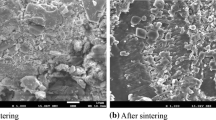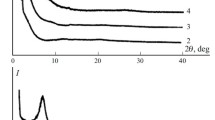Abstract
Considering equipment damage, energy consumption enhancement and efficiency reduction during undesirable solidification process, this paper experimentally investigated the ability of clay nanoparticles to hinder the solidification procedure. The nanofluids were prepared by dispersing various concentrations of clay nanoparticles (0.01 wt.%, 0.02 wt.% and 0.04 wt.%) in deionized water without any dispersants. The solidification characteristics of nanofluids were determined by using cooling generator system. The experimental results of clay nanofluids showed a reduction in the nucleation temperature and an enhancement of supercooling degree of about 25% during solidification process due to reduction in heat transport properties. According to the comparison results, it was construed that providing supercooling condition, lower density nanoparticles are more able to advance in nucleation phenomenon and also higher thermal conductivity nanoparticles have more tendency to reduce supercooling degree. Therefore, considering desirable and undesirable solidification, the best possible candidate of nanoparticles can be utilized based on their thermophysical properties.









Similar content being viewed by others
Abbreviations
- ΔH:
-
Phase change enthalpy, kJ.
- ΔE :
-
Total errors.
- K :
-
Thermal conductivity, W.m−1 K−1.
- \( \dot{Q} \) R :
-
Cooling rate of refrigerator, kW.
- S m :
-
Standard error.
- T ph :
-
Phase change temperature, K.
- T n :
-
Nucleation temperature, K.
- t :
-
Time, S.
- X :
-
Measuring value.
- \( \overline{X} \) :
-
Average measuring value.
- ρ :
-
Density, kg.m−-3.
- σ s :
-
Sample standard deviation.
- ϕ :
-
Volume fraction.
- BF :
-
Basefluid.
- NF :
-
Nanofluid.
- P :
-
Particle.
- ESD:
-
Enhancement of Supercooling Degree
- MD:
-
Mean Deviation
- ONT:
-
Onset Nucleation Time, S
- ONTR:
-
Onset Nucleation Time Ratio
- RE:
-
Random Error
- SD:
-
Supercooling Degree, oC
- SDR:
-
Supercooling Degree Ratio
- SE:
-
Systematic Error
- WST:
-
Whole Solidification Time, S
- WSTR :
-
Whole Solidification Time Ratio
References
Ismail KAR, Filho LMS, Lino FAM (2012) Solidification of PCM around a curved tube. Int J Heat Mass Transf 55:1823–1835
Jia L, Peng L, Chen Y, Mo S, Li X (2014) Improving the supercooling degree of titanium dioxide nanofluids with sodium dodecylsulfate. Appl Energy 124:248–255
Hoseinzadeh S, Ghasemiasl R, Havaei D, Chamkha AJ (2018) Numerical investigation of rectangular thermal energy storage units with multiple phase change materials. J Molecular Liquids 271:655–660
Nematpour Keshteli A, Sheikholeslami M (2019) Nanoparticle enhanced PCM applications for intensification of thermal performance in building: a review. J. Molecular Liquids 274:516–533
Motahar S, Alemrajabi AA, Khodabandeh R (2017) Experimental study on solidification process of a phase change material containing TiO2 nanoparticles for thermal energy storage. Energy Convers Manag 138:162–170
Fan LW, Yao XL, Wang X, Wu YY, Liu XL, Xu X, Yu ZT (2015) Non-isothermal crystallization of aqueous nanofluids with high aspect-ratio carbon nano-addi- tives for cold thermal energy storage. Appl Energy 138:193–201
Chandrasekaran P, Cheralathan M, Kumaresan V, Velraj R (2014) Solidification behavior of water based nanofluid phase change material with a nucleating agent for cool thermal storage system. Int J Refrig 41:157–163
Altohamy AA, Abd Rabbo MF, Sakr RY, Attia AA (2015) Effect of water based Al2O3 nanoparticle PCM on cool storage performance. Appl Therm Eng 84:331–338
Chandrasekaran P, Cheralathan M, Kumaresan V, Velraj R (2014) Enhanced heat transfer characteristics of water based copper oxide nanofluid PCM (phase change material) in a spherical capsule during solidification for energy efficient cool thermal storage system. Energy 72:636–642
Mo S, Chen Y, Cheng Z, Jia L, Luo X, Shao X, Yuan X, Lin G (2015) Effects of nanoparticles and sample containers on crystallization supercooling degree of nanofluids. Thermochim Acta 605:1–7
Jean DS, Lee DJ, Wu JCS (1999) Separation of oil from oily sludge by freezing and thawing. Wat Res 33:1756–1759
Hu G, Li J, Hou H (2015) A combination of solvent extraction and freeze thaw for oil recovery from petroleum refinery wastewater treatment pond sludge. J Hazard Mat 283:832–840
Zhou P, Wang H (2014) Carbon capture and storage—solidification and storage of carbon dioxide captured on ships. Ocean Eng 91:172–180
Pesonen J, Yliniemi J, Illikainen M, Kuokkanen T, Lassi U (2016) Stabilization/solidification of fly ash from fluidized bed combustion of recovered fuel and biofuel using alkali activation and cement addition. J Env Chem Eng 4:1759–1768
Lu T, Wang KS (2008) Numerical analysis of the heat transfer associated with freezing/solidifying phase changes for a pipeline filled with crude oil in soil saturated with water during pipeline shutdown in winter. J Pet Sci Eng 62:52–58
McDonald A, Bschaden B, Sullivan E, Marsden R (2014) Mathematical simulation of the freezing time of water in small diameter pipes. Appl Therm Eng 73:142–153
Xu G, Qi J, Jin H (2010) Model test study on influence of freezing and thawing on the crude oil pipeline in cold regions. Cold Reg Sci Tech 64:262–270
Zhao Y, Yu B, Yu G, Li W (2014) Study on the water-heat coupled phenomena in thawing frozen soil around a buried oil pipeline. Appl Therm Eng 73:1477–1488
Li G, Sheng Y, Jin H, Ma W, Qi J, Wen Z, Zhang B, Mu Y, Bi G (2010) Development of freezing–thawing processes of foundation soils surrounding the China–Russia crude oil pipeline in the permafrost areas under a warming climate. Cold Reg. Sci. Tech. 64:226–234
Zhang X, Wu X, Min J (2017) Freezing and melting of a sessile water droplet on a horizontal cold plate. Exp Thermal Fluid Sci 88:1–7
Moghiman M, Aslani BH (2013) Influence of nanoparticles on reducing and enhancing evaporation mass transfer and its efficiency. Int J Heat Mass Transf 61:114–118
Tournassat C, Gaboreau S, Robinet JC, Bourg IC, Steefel CI (2016) Impact of microstructure on anion exclusion in compacted Clay Media, chapter 11. The Clay Minerals Society Workshop Lectures Series 21:137–149
Rezvani P, Taghizadeh MM (2018) On using clay and nanoclay ceramic granules in reducing lead, arsenic, nitrate, and turbidity from water. Appl Water Sci 8:131
Kumar PS, Senthil SM, Pal SK and Rajasekar R (2017) Organic-Inorganic Composite Polymer Electrolyte Membranes Chapter 6, Organic/Montmorillonite Nanocomposite Membranes, Springer International Publishing AG. 159–160
Yu QL (2019) Application of nanomaterials in alkali-activated materials, Chapter 5, Nanotechnology in Eco-efficient Construction, Elsevier Woodhead Publishing Series in Civil and Structural Engineering. 97–121
Folaranmi J (2009) Effect of additives on the thermal conductivity of clay. Leonardo J Sci 14:74–77
Kaloyerou PN (2018) Basic Concepts of Data and Error Analysis, Chapter 3, Error Analysis, Springer International Publishing AG, part of Springer Nature 27–59
Aslani H, Moghiman M (2018) Experimental study on the effect of zirconia nanoparticles on solidification heat transfer characteristics: a comparison with Titania nanoparticles. Int J Refrig 89:40–50
Wu S, Zhu D, Li X, Li H, Lei J (2009) Thermal energy storage behavior of Al2O3-H2O nanofluids. Thermochim Acta 483:73–77
Wang XJ, Li XF, Xu YH, Zhu DS (2014) Thermal energy storage characteristics of cu-H2O nanofluids. Energy 78:212–217
Hossain R, Mahmud S, Dutta A, Pop I (2015) Energy storage system based on nanoparticle-enhanced phase change material inside porous medium. Int J Therm Sci 91:49–58
Teng TP (2013) Thermal conductivity and phase change properties of aqueous alumina nanofluid. Energy Convers Manag 67:369–375
He Q, Wang S, Tong M, Liu Y (2012) Experimental study on thermophysical properties of nanofluids as phase-change material (PCM) in low temperature cool storage. Energy Convers Manag 64:199–205
Mo S, Chen Y, Jia L, Luo X (2012) Investigation on crystallization of TiO2–water nanofluids and deionized water. Appl Energy 93:65–70
Liu Y, Li X, Hu P, Hu GA (2015) Study on the supercooling degree and nucleation behavior of water-based graphene oxide nanofluids PCM. Int J Refrig 50:80–86
Jagannadham K (2011) Orientation dependence of thermal conductivity in copper-graphene composites. J Appl Phys 110:1–6
Kwak K, Kim C (2005) Viscosity and thermal conductivity of copper oxide nanofluid dispersed in ethylene glycol. Korea-Australia Rheology J 17:35–40
Williams W, Buongiorno J, Hu LW (2008) Experimental investigation of turbulent convective heat transfer and pressure loss of alumina/water and zirconia/water nanoparticle colloids (nanofluids) in horizontal tubes. J Heat Transf 130:042412–042411
Acknowledgments
The authors gratefully acknowledge the financial support from the Ferdowsi University of Mashhad.
Author information
Authors and Affiliations
Corresponding author
Ethics declarations
Conflict of interest
On behalf of all authors, the corresponding author states that there is no conflict of interest.
Additional information
Publisher’s note
Springer Nature remains neutral with regard to jurisdictional claims in published maps and institutional affiliations.
Rights and permissions
About this article
Cite this article
Aslani, H., Moghiman, M. Influence of clay nanoparticles on hindering the undesirable solidification process. Heat Mass Transfer 56, 789–796 (2020). https://doi.org/10.1007/s00231-019-02743-6
Received:
Accepted:
Published:
Issue Date:
DOI: https://doi.org/10.1007/s00231-019-02743-6




